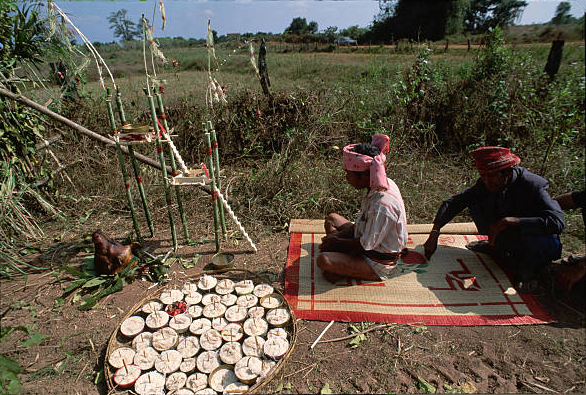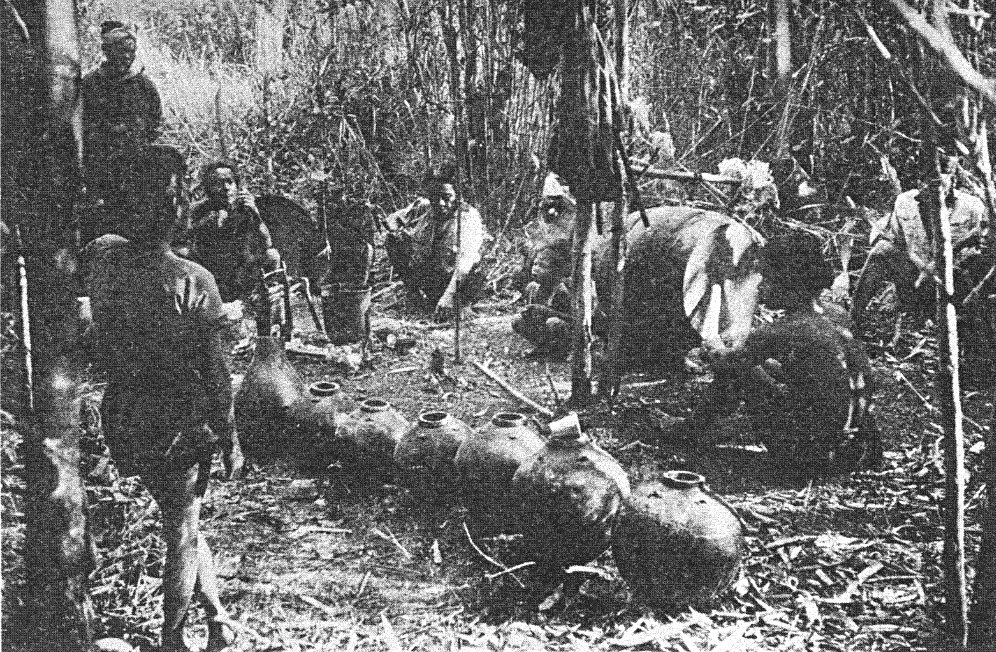Your search results [1 article]
Rice beer and the great sacrifice of the buffalo: the Mnong of Vietnam.
The M'nong Gar live on the highlands of Vietnam, in the midst of other peoples whom the Vietnamese of the plains call " Mountaineers ", or in a more contemptuous manner : Moï ("Savages"). Vietnam is a multi-ethnic country. The M'nong are the heirs of the ancient settlements of Southeast Asia. They were gradually pushed back to the highlands, forests and jungle by the rice-growing peoples of the fertile coastal plains. By the Champa first from the 2th to the 15th century, themselves sinized over the centuries by populations from Southern China.
The M'nong Gar were about 100,000 at the beginning of the 21th century, living in the provinces of Dak Lak, Dak Nong, Lam Dong, Binh Duong and Binh Phuoc. The M'Nong language belongs to the Mon-Khmer linguistic group.
The M'nong Gar practice slash-and-burn agriculture in the heart of a wide forest plateau watered by a tributary of the Mekong. Each village moves, year after year, from one piece of exploited forest to another, according to a long cycle of 10 to 20 years which allows the ecosystem to reconstitute itself without ever exhausting or destroying it.
 The cultivation of rice is important among the M'nong Gar. Rice is used both as food and as a raw material to brew the cultural beverage of the M'nong: the rice beer. For the M'nong, who are unparalleled rice farmers and horticulturists, rice beer ensures the smooth running of the agricultural cycle. It is offered as a libation to the natural powers that allow plants to grow and humans to eat and drink. Offerings of rice beer therefore take place at each key moment in the agricultural cycle: clearing, sowing, harvesting.
The cultivation of rice is important among the M'nong Gar. Rice is used both as food and as a raw material to brew the cultural beverage of the M'nong: the rice beer. For the M'nong, who are unparalleled rice farmers and horticulturists, rice beer ensures the smooth running of the agricultural cycle. It is offered as a libation to the natural powers that allow plants to grow and humans to eat and drink. Offerings of rice beer therefore take place at each key moment in the agricultural cycle: clearing, sowing, harvesting.
The rice beer is also a central component in the buffalo sacrifice. This spectacular ceremony unites an entire village. It marks important moments in the life of the community. The family or village that engages in this ceremony uses a lot of resources, time and social ties to carry out this sacrifice, which in turn brings prestige and broader social alliances. A buffalo and dozens of jars of rice beer are part of the expense involved. Buffalo and rice beer are offered to the tutelary powers whose protection is sought.
The sacrifice of the buffalo and rice beer offerings are among the major rituals of the ancient peoples of Southeast Asia, beyond the borders of M'nong country. Their equivalents exist in Cambodia and Laos[1].
During the buffalo sacrifice, the M'nong attach a jar containing rice beer to a stake, specially carved for the occasion. The pole and the jar of beer are essential for the accomplishment of the ceremony.
Here are the questions usually raised by the theme of the bloody sacrifice: Why are animals killed? What do we hope to achieve by shedding the blood of a buffalo? Sacrifice means eating with the gods. It is also a way to give human beings their proper status, between beasts and gods.
However, why a jar of beer hanging from the sacrifice pole?
The question of animal meat does not give all the answers. The rice beer, a beverage of plant origin, a priori has no connection with the bloody sacrifice.
Documentary on the Mnong-gar ( excerpt). The stake and the jar of rice beer. Sacrifice of the buffalo. Jean-Loïc_Portron 2008. The jar of beer shelters the protective spirit of a household. It is filled with cooked rice and ferments, then sealed. A slow conversion of the rice into sugars begins under the action of the microscopic fungi brought by the ferments. At the same time, alcoholic fermentation begins. These two fundamental transformations continue for several months in the enclosed jar. The jar therefore contains a living beer, a continuous fermentation of the rice. When the protective spirit of the household asks for a sacrifice, it makes it known by a dream or a sign. A sacrifice is then organised in his honour, that of a chicken. Its blood is anointed on the jars of beer, the gong and the stake. Then one or several jars of rice beer are opened. The beer is slowly sucked out with long, thin tubes of bamboo.
" It's just to remember the event. Once the ceremony is over, it is thrown into a corner.
We believe that objects have a soul. We think that the soul of a jar, of a gong is very close to that of a human being. We consider it to be a child of the house.
Offerings are made following a dream. If spirits appear to the master of the house to reproach him, he will immediately think that it is the spirit of the jar. The jar wants people to make offerings because it has not been used for a long time. It is sad. The day after the dream, the master of the house is going to kill a chicken for an offering ritual which is called the ritual of the promise. "
... after the offering, the gongs resound and we together drink the rice beer with long bamboo tubes.
Among all the proto-Indochinese peoples, the rice beer jars hold a prominent place in social life and ceremonies.
The rnoom, the rice beer, is based on crushed rice and rice bran. The mixture (coot) is macerated for a few days in a hermetically sealed beer jar (yang), one month at the most for special ceremonial beers. In the jar, the rice hydrolyses and ferments at the same time. The rice bran carries hydrolysing moulds and wild yeasts. The coot remains partially thick.
The jar is opened at the last moment. A little coot is set aside for anointing if a sacrifice is being prepared. At the time of serving the beer, a large volume of water is added at the very edge, to dilute the coot. The jar is stuffed with yang grasses and foliage to keep the solid residues at the bottom of the jar. The supernatant, about ten litres per jar, in other words the rnoom, is ready to be drunk collectively. It is first consecrated with a few verses accompanied by a few drops poured on the ground.
A drinking tube (gut) is stuck into the jar. This long and flexible reed is used to suck up the rnoom from the bottom of the jar, i.e. near the fermented mass with the highest alcohol content. Each drinker must suck up two measures of beer before passing the tube to his neighbour. The measure of beer is equal to the volume of water added to the jar by the person who acts as cup-bearer and ensures that the collective drinking goes smoothly. He holds a hollow bamboo tube or a buffalo horn, with which he pours twice its volume of water after each drinker. The level of the beer has to come back up to the rim of the jar each time, which verifies that each drinker has actually sucked up his or her allowed volume of beer. The measurements are always counted in pairs[2].
This way of drinking ensures that everyone sucks in the same amount. The beer, which is initially strong, becomes weaker and weaker in alcohol and taste as it is sucked in and water is added. By mutual agreement, the drinking stops when the rnoom no longer has any strength.
The Mnong Gar only drink the rnoom on certain circumstances: religious ceremonies, collective celebrations, coming of a foreigner. They never drink alone. They never organize a collective drinking without a serious motive and the collective assent. Men and women drink the rice beer, indiscriminately, together for collective celebrations (feasts, weddings, offerings for agrarian rites, ...). Men alone drink it when a master of the house honours "the spirit that animates the protective jar of the household" (see video). They also empty jars of rice beer when they go hunting or clear and burn a new land to prepare it for rice cultivation.
[1] In order to discover them, you have to cross mental and cultural borders, rather than geographical or material ones. These cultural spaces-time are in fact masked, even occulted, by the more recent cultural strata: Buddhism from India (-300), Champa royalties (2nd-15th centuries), Chinese expansion (Qing dynasty 1644-1911), Western colonisation (19-20th century), modern state organisation. Once these layers have been cleared one by one, the historical onion peeled, the cultural life of the M'nong people is no longer veiled by the "primitivist" gaze. Their material and spiritual life becomes as legitimate as that of an inhabitant of Ho Chi Minh, New York or Beijing. Ethnologists are often the only ones able to travel into the combined present and past of the peoples.
[2] Georges Condominas 1982, Nous avons mangé la forêt de la Pierre-Génie Gôo (Hii saa Brii Mau-Yaan Gôo). Chronique de Sar Luk, village Mnong Gar. (1ère éd. Mercure de France 1957)



